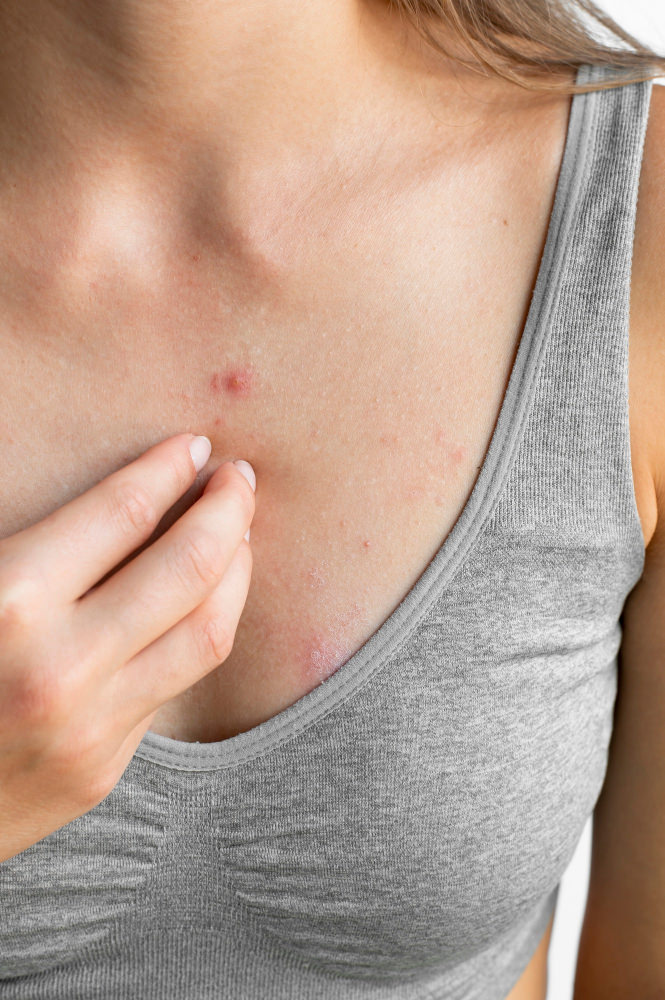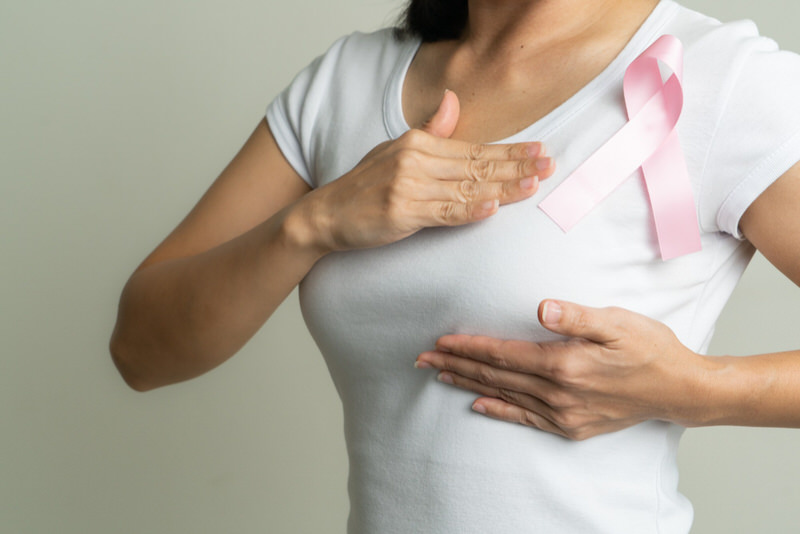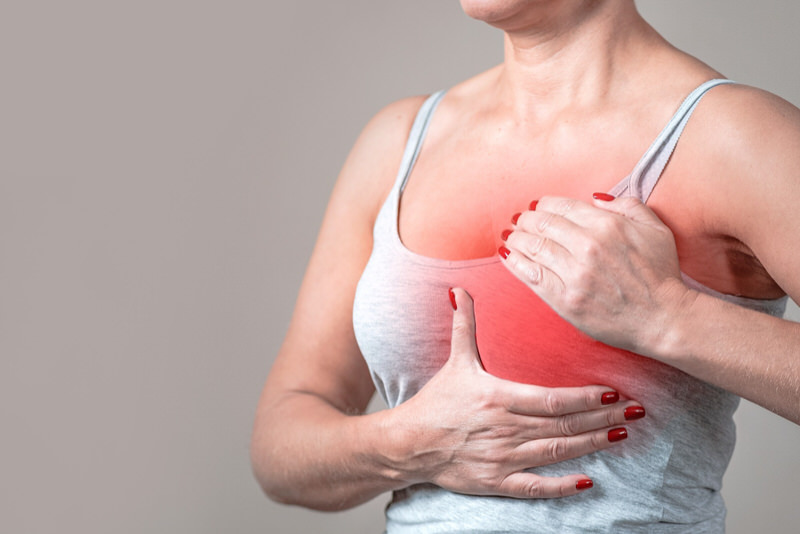A red spot on your breast can stem from various causes, usually involving a rash, skin condition, infection, allergic reaction, or a bug bite. A red spot on your breast could also signify a rare type of cancer like inflammatory breast cancer (IBC), where the skin appears to be like an orange peel with redness and swelling accompanied. It could also be an early symptom of Paget’s breast disease, where cancer starts from the nipple. Visit a doctor immediately if you have a family history of cancer for an early diagnosis. You can choose to treat a rash or other skin conditions at home by using home remedies or can easily get it treated by visiting a dermatologist.
It’s been days, but the red spot on your breast hasn’t gone away or subsided. It’s enough to make any woman spiral down in a world of worry. A red spot like that on your breast could also be itchy for now, and if it hasn’t disappeared in a week could mean different things.
It can be very uncomfortable as you can’t itch on them in public, and you might desperately want to get rid of it as quickly as possible. But if your spot doesn’t go away, you might want to take a closer look at it.
The red spot could be a rash, a bug bite, pimple, or an initial symptom of a severe issue. Are you curious about what could be causing this spot to appear on your breast? Let’s not spiral down yet and approach it with various possible causes.
Possible causes of red spot on breast
You see a red-colored spot on your breast, and you don’t worry that much thinking it would probably subside in a couple of days. But it has been a week, and the spot is still there, only now it itches like crazy and could also be looking like a hickey.
Of course, surfing the internet to find your answers is what you do right away, only to meet with posts telling you it’s something serious throwing you into worry.
But the worst-case scenario is not the only scenario. The red spot you see on your breast could be caused due to a couple of issues with your skin that can be remedied easily. Let’s explore some of the possible causes.
Intertrigo

It can be described as a rash that you might get on your breasts because of sweat irritation or your skin folding from where the rash appears to be. It usually appears underneath or between the breasts.
If not taken care of on time and left unattended, this rash can develop into yeast or bacterial growth, becoming a more serious issue.
You can treat this and prevent further infections by keeping your affected and surrounding area dry and clean as much as possible.
Showering often is helpful to avoid sweat from irritating. Allow your skin to breathe by wearing a comfortable cotton bra and loose clothing items.
For further treatment, you can use over-the-counter creams prescribed by your doctor.
Contact Dermatitis
Another possible reason for the red spot you see on your breasts could be because something is causing irritation to your skin in that area and causing an allergic reaction.
Contact dermatitis is when a red itchy rash appears, in this case, on your breast. There must be some fabric or dye in the fabric, detergent, or even fragrance responsible for this reaction.
It’s common for breastfeeding people to have this red spot appear near their areola.
The best treatment to prevent this condition is to see what’s causing it in the first place and change things accordingly.
If you’re still having problems, then see a dermatologist.
Yeast infection
A yeast infection is a common occurrence in breastfeeding people. Thrush occurs in the areola area or in nursing mothers, and it can even affect the baby. The symptoms include irritated, shiny, or flaky nipples.
Antifungal creams help out people suffering from this issue. Also, to avoid sugar which promotes the growth of yeast.
If you’re breastfeeding, then sanitize bottles, nipples, pacifiers, and everything that might go in your baby’s mouth. Also, wash your bras in hot water to prevent infections.
Breast abscess
A breast abscess is developing pus from a bacterial infection in the breast. The bacteria gets inside through the nipple and can be painful, and it mostly affects breastfeeding women.
It’s treatable through antibiotics, needle aspiration, or drainage.
Mammary duct ectasia
It’s a condition that affects the mammary glands in the way that ducts become wider and the walls thicker leading up to a blockage and buildup of fluid.
There’s nipple discharge and redness or tenderness of the nipple and areola.
It usually occurs in women undergoing menopause but can also affect younger women, men, or children.
Mastitis
Mastitis, a bacterial infection, is a painful inflammation of the breast caused due to milk trapped in the breast.
Apart from a red spot, you might be able to notice other symptoms like redness, warmth, and tenderness of the affected breast. If not treated on time can also lead to fever and further infection of septicemia.
Home remedies to get rid of red spots on breast
There could be several causes behind the appearance of red spots on your breast. You might need treatment from a dermatologist for severe cases, but in the beginning, you can try to treat it with some home remedies such as:
Tea tree oil
Tea tree oil is widely known for its ability to get rid of rashes and work as a remedy for various skin conditions such as acne, pimples, eczema, and more.
It’s quite an effective oil with antifungal and anti-inflammatory properties. It prevents the growth of fungi and infections while reducing swelling and inflammation.
You can’t apply it directly but have to dilute the 1-2 drops of tea tree oil with 12 drops of other oil such as olive, coconut, or almond.
Lemon juice
Lemon juice also has antifungal properties, which help prevent any infection from developing. It soothes the skin with its anti-microbial effects and speeds up the healing process.
Lemon juice also has astringent qualities due to the acidic level, which helps decrease inflammation and oil formation that makes a red spot develop into a pimple.
Cornstarch
Another remedy is to use cornstarch on the affected area as it absorbs moisture and sweat and helps keep the skin dry, and helps relieve the burning sensation and itching caused due to the rashes.
You have to be cautious using cornstarch if it’s not a rash but a fungal infection.
Using cornstarch will further the growth of fungal infection as it feeds on cornstarch. In this case, you should be using talcum powder instead.
Basil leaves
Basil leaves have great medicinal purposes and many health benefits. It’s loaded with vitamin A and C, calcium, iron, zinc and has anti-inflammatory and anti-microbial properties rich in antioxidants.
It instantly provides cooling to the affected area and relieves the itching and tingling sensation that furthers the problem in rashes.
Aloe vera
Everyone knows how popular aloe vera is in treating skin problems.
When applying it to rashes, it serves as a great cooling down of the rashes and soothes the affected area by reducing inflamed skin and itching down to a great extent.
It possesses antifungal and antibacterial properties. It’s a great natural treatment for problems like these.
Can a red spot be a sign of breast cancer?

On the one hand, a red spot on your breast could signify some skin condition or infection developing into a rash. On the other hand, it could also be a symptom of something serious like breast cancer.
You might be wondering, if that were to be true, why don’t you feel a lump in your breast because we have been told that’s the sign of breast cancer. While catching a lump is a sign of breast cancer, that’s not always true for all kinds of breast cancer.
Inflammatory breast cancer
In Inflammatory breast cancer (IBC), we can see red spots on the breast, looking like an insect bite, hickey, or rash. IBC usually doesn’t cause lumps but appears like an orange peel with redness and swelling.
Although this kind of cancer is aggressive, it’s also quite rare, making up only 2-4 percent of cases in the United States.
In IBC, you don’t get to see lumps, but there are red spots along with other symptoms like:
- rapid changes in the skin around the affected breast
- breast swelling
- breast pain
- itchiness
- thickening of the breast skin
- redness and warmth of the skin on the breast
- enlargement or heaviness of the affected breast
- breast skin that feels and appears thick and pitted, similar to an orange peel
IBC can grow quickly, so an early diagnosis is probably the best option to get rid of it. Your doctor will recommend treatments like chemotherapy, surgery, and radiation therapy.
Paget’s disease
Paget’s disease of the breast or nipple is also another type of rare breast cancer where one can see red spots as a prominent symptom. It affects about 1-4 percent of people and is common among older people as a rare disease.
Usually starting from the skin of the nipple, it then spreads to the areola, furthering to the skin around the areola. It only affects one nipple and can be mistaken for eczema or dermatitis.
Other than the red spot, it includes other symptoms like:
- scaly, red, thickened and crusted skin
- dry skin
- change of color
- pain or itching
- inversion or deformation of nipple
- yellowish fluid or blood coming out of the nipple
- sort of a lump in the breast
You’ll likely need surgery based on the condition of your skin around the nipple and how advanced the underlying cancer is.
When to see the doctor
When the red spot first appears on your breast, you need to be patient for a week and see if any changes occur. Instead of being scared right away, try to see what the red spot is trying to signify is wrong with your body.
The red spot or rash should go away in a week in most cases, and this could mean a skin condition, allergy, pimple, or bug bite. In this case, you need not worry immediately and only seek a doctor if things start getting worse with the red spot.
If the red spot is still visible even after a week, and you start seeing other visible changes in your breast, nipple, and areola, then there might be a possibility of breast cancer. Don’t ignore your condition, like changing shape and breast pain, if you have a family history of breast cancer.
The good news is that early detection can help you immensely get the proper treatment at the right time. Any delay can worsen your condition, so it’s right to seek medical advice if you doubt your condition is not improving with other symptoms.
FAQs
What does breast cancer redness look like?
There’re several kinds of breast cancer where some are common types and some quite rare, like IBC or Paget’s breast disease. Many red spots appear, which is a prominent indication of breast cancer.
A red or purple-colored rash covers one-third of the breast. There is a change in the breast’s size, skin color, nipple inverted as some common indications. Your skin could also start to appear like an orange peel.
What do leukemia red spots look like?
Someone who has leukemia might also witness red spots on their skin. These are pretty tiny red spots of blood called petechiae, and they appear as red spots on light skin, and on darker skin, it’s less noticeable.
It’s most likely to occur where blood is likely to accumulate, like on your hands, feet, and arms. The red spots are caused by tiny broken blood vessels, called capillaries, under the skin. Usually, platelets help your blood clot, but for someone with leukemia, the body doesn’t have enough platelets to do so.
Can a bra cause rash on the breast?
Any tight clothing can cause the skin to fold and sweat to accumulate. It causes irritation and a rash on the skin, commonly known as contact dermatitis.
There appears to be a red rash that is severe, dry, cracked, and scaly skin. There could be bumps and blisters, which sometimes oozes and crust accompanied.
What does a breast yeast rash look like?
A yeast infection on the breast is prominent as a rash. The person suffering from it can experience itching, burning, pain, skin crack, and bleed as it becomes severe. Smaller patches of the rash are visible all around the breast.
How do you tell if a rash is fungal or bacterial?
Skin infections caused by viruses are red blisters, which are itchy and painful when becoming severe. Fungal infections are typically red, scaly, and itchy rash.
When you see all these kinds of symptoms, then it’s best to seek a proper diagnosis and treatment from a dermatologist instead of treating it yourself.
To summarize
A red spot on your breast could mean different things, including as simple as a rash or a bug bite, or can indicate a more severe issue like breast cancer. Being observant of your red spots is critical for you to do right now to recognize what it is.
An indication of breast cancer would entail some change in your breast, and you can sense that and immediately visit your doctor if you’re observant. An early diagnosis can prevent further growth and better treatment of the issue.
Otherwise, if it’s a bug bite, rash, or any skin condition, you can visit your dermatologist and get yourself treated. Or, if you’re looking to treat it at home, some home remedies I’ve mentioned can prove to be helpful.
If your condition is becoming severe in any way, it’s better to see your doctor right away.




